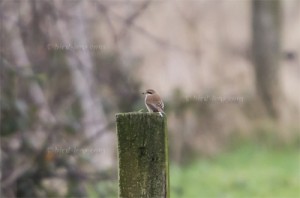 During a short trip to experience the long-staying Brown Shrike (Lanius cristatus) – a first for the Netherlands – we made this remarkable sighting. After visiting the sites of the website of the birding community in the Netherlands “waarneming.nl” we decided to head for this vagrant Shrike near the German border between Doetinchem and Emmerich. The bird has been present in Netterden – in the Netterdensche Broek – in Gelderland for more than two weeks now. The Brown Shrike had been found near Gendringen at the January, 18th 2014, in the utmost south-east of the province of Gelderland not far from the German border. The first-winter individual has being quite cooperative and we decided we wanted to see it. The regular range of the Brown Shrike (Lanius cristatus) extends from central Siberia over Kamchatka, Sakhalin and northern Japan. In the south it extends to the Altai Mountains, Mongolia, Manchuria and Korea and China. The habitat is the boreal and arctic zone and steppe and desert zones and mountain regions. Thus an observation in the Netherlands is a real exception.
During a short trip to experience the long-staying Brown Shrike (Lanius cristatus) – a first for the Netherlands – we made this remarkable sighting. After visiting the sites of the website of the birding community in the Netherlands “waarneming.nl” we decided to head for this vagrant Shrike near the German border between Doetinchem and Emmerich. The bird has been present in Netterden – in the Netterdensche Broek – in Gelderland for more than two weeks now. The Brown Shrike had been found near Gendringen at the January, 18th 2014, in the utmost south-east of the province of Gelderland not far from the German border. The first-winter individual has being quite cooperative and we decided we wanted to see it. The regular range of the Brown Shrike (Lanius cristatus) extends from central Siberia over Kamchatka, Sakhalin and northern Japan. In the south it extends to the Altai Mountains, Mongolia, Manchuria and Korea and China. The habitat is the boreal and arctic zone and steppe and desert zones and mountain regions. Thus an observation in the Netherlands is a real exception.
We arrived there at 14.30. Heavy clouds were on the sky, but it was not raining. After a while, the bird was sitting in some small tree and thorn bushes opposite a gravel pit, just 300m away from us. What a bird. A first for the Netherlands and a bird also very rare for the Western Palearctic. Some Images of proof you will find in the Gallery.
This Brown Shrike (Lanius cristatus) showed his striking head pattern: white supercilium, on the upper side the head is light brown. The black eye stripe and the whitish cheek are clearly visible. The back is brownish, secondaries form a whitish panel. The rounded tail is brownish. The barring on the under parts show the characteristics of a 1st-winter individual. The Brown Shrike (Lanius cristatus), is an Asian species of the family of the Shrikes, Laniidae. There are three subspecies. In Europe, this species has been observed up to that sighting only eight times before and only once so far in Central Europe, where an adult female was observed on Helgoland in October 2001.
To cope with the growing demand for top shots of the rarer species of the Palearctic Bird-Lens is keen to enrich the range of pictures of birds you can find in the western palearctic. Trips to remote places like this one to capture images of rare birds of western palearctic were very successful. The nice images you find in the gallery are only a first impression, what you will find in the gallery in the “Pictures Shop” very soon. Just give me a message, if I could serve you with an image needed before the new pictures are online.
Other successful shootings you can see under: www.bird-lens.com in the pictures shop.